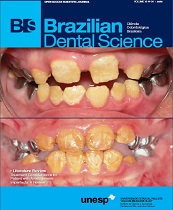Diagnosis of a horizontal root fracture during retreatment of a maxillary canine utilizing an electronic apex locator and monitoring with CBCT: a case report
DOI:
https://doi.org/10.14295/bds.2013.v16i4.923Resumo
Introduction: The aim of this case report is todemonstrate the retreatment of a maxillary caninediagnosed with a horizontal root fracture utilizingan electronic apex locator and monitored with conebeam computed tomography. Case Report: A 35year old African American male was referred for rootcanal retreatment of a maxillary right canine prior toprosthetic rehabilitation. Following removal of guttapercha, an apex locator was utilized to determine thelength of the root canal. After a more comprehensivedental history, the patient confirmed a previouslyunreported history of dental trauma at this time,leading to the suspicion of a horizontal root fracture.Clinical microscopy detected a connective tissue in theapical third of the root canal and multiple periapicaland occlusal radiographs enhanced visualizationof a horizontal root fracture. The coronal segmentwas filled with an MTA apical plug and the apicalsegment remained stable. A recall after 1.5 yearswas performed with CBCT, which showed no apicalradiolucency. Discussion: The present case reportreinforces the precept that detailed dental history andcareful observation of radiographs are critical factorsfor obtaining an accurate diagnosis. Fundamentaladjuncts, such as microscopy, apex locators andCBCT imaging, can potentially aid in the diagnosisand the subsequent treatment plan of horizontal rootfracture.
Keywords
Cone-beam computed tomography; Apex locator Cuspid; Radiography; horizontal root fracture.
Downloads
Downloads
Arquivos adicionais
Publicado
Como Citar
Edição
Seção
Licença
TRANSFERÊNCIA DE DIREITOS AUTORAIS E DECLARAÇÃO DE RESPONSABILIDADE
Toda a propriedade de direitos autorais do artigo "____________________________________________________________________" é transferido do autor(es) para a CIÊNCIA ODONTOLÓGICA BRASILEIRA, no caso do trabalho ser publicado. O artigo não foi publicado em outro lugar e não foi submetido simultaneamente para publicação em outra revista.
Vimos por meio deste, atestar que trabalho é original e não apresenta dados manipulados, fraude ou plágio. Fizemos contribuição científica significativa para o estudo e estamos cientes dos dados apresentados e de acordo com a versão final do artigo. Assumimos total responsabilidade pelos aspectos éticos do estudo.
Este texto deve ser impresso e assinado por todos os autores. A versão digitalizada deverá ser apresentada como arquivo suplementar durante o processo de submissão.




























